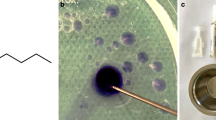Abstract
Embolization of cerebral aneurysms has become a common technique. Its impact on subsequent medical management of the patient is not well known. We report two patients who presented in a poor neurological grade after subarachnoid hemorrhage from posterior communicating artery aneurysms. Both were treated by coil embolization and both developed subclavian vein thrombosis, requiring systemic anticoagulation, initiated 11 and 21 days after embolization, respectively. Both developed a large, fatal intracranial hemorrhage adjacent to the embolized aneurysm in the fourth week of anticoagulation. Systemic anticoagulation of patients who have had a ruptured aneurysm treated by coil embolization may carry a significant risk of rebleeding. Alternate management strategies should be considered in these patients.
Similar content being viewed by others
Author information
Authors and Affiliations
Additional information
Received: 21 January 2000 Accepted: 3 October 2000
Rights and permissions
About this article
Cite this article
Sinson, G., Bagley, L., Flamm, E. et al. Fatal rebleeding following coil embolization of cerebral aneurysms: the role of long-term systemic anticoagulation. Neuroradiology 43, 398–404 (2001). https://doi.org/10.1007/s002340000497
Issue Date:
DOI: https://doi.org/10.1007/s002340000497




